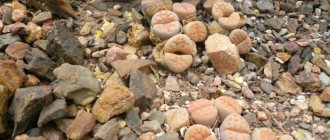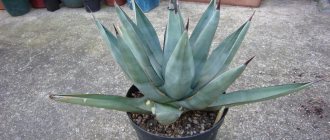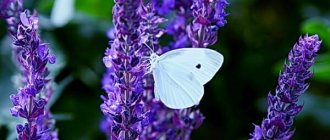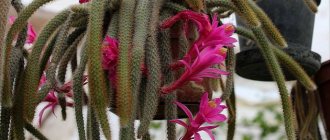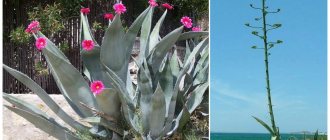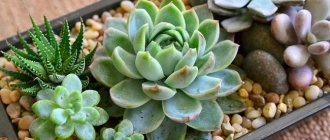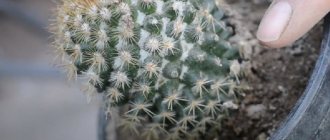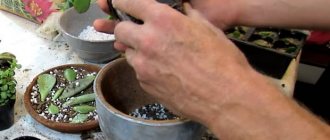Description and features of the genus Agave
The genus Agave unites the subfamily Agavoideae (Agave) from the Asparagaceae family. It lists about 400 varieties of crops that are widespread in Central America, the southern regions of the United States, and the Caribbean islands.
Agave in natural conditions
All species of the genus Agave are characterized by large leaves that form rosettes with a diameter of 16 cm to 6 meters. The leaves of each species vary in size, shape, texture and color. As a rule, in most varieties of Agave, the edges of the leaf blades are covered with spines of different sizes, and at the tips of the leaves there are hard, sharp spines. Although there are types of succulent without thorns with soft, leathery leaves. The appearance of crops, based on the variety, may differ significantly. The shade can be green, bluish-green, gray, and there are also varieties with stripes of white or yellow.
Many members of the genus are accustomed to growing in the wild, mainly in desert and highland areas. Agave roots allow the plant to fill with moisture from various sources - rain, condensation or dew.
Agave flowers
Seeing this beauty bloom is a rare occurrence, as it happens once every 30-60 years. In this case, a long arrow is formed, on which a spikelet or panicle grows. In some species the peduncle can reach 10 meters. Flowering duration is 24 hours. In this short time, you can admire more than a hundred miniature yellowish-green bells. Most Agave species are monocarpic succulents. After flowering and fruit development, the central rosette dies. That is why it is believed that the Agave plant blooms once in its life.
Initially, crops appeared in Europe in the 2nd half of the 16th century, gaining wide popularity as exotic ornamental plants. Now they can be grown on the streets, in gardens, in greenhouses, and also indoors (depending on the region).
Agave is often confused with cacti, Aloe and other crops. Although they are characterized by such a feature as succulence (collection and retention of moisture in various plant structures), each group belongs to different families. Cacti and sedums are classified as Eudicots, while Agave and Aloe are classified as monocots. Agave is often compared to Aloe, but they are also representatives of different families. Aloe belongs to the Asphodelaceae family.
Reproduction methods
Agave propagation by offspring
During the growing season, suckers form near the base of the trunk of the domestic agave
If necessary, they can be carefully separated. Leave the shoots in the open air for a while so that the cut area dries well.
Plant the offspring in small pots filled with moist substrate. The first watering is carried out after two or three days. Until the shoots sprout roots, the soil mixture is moistened very carefully with a thin stream. This will prevent the substrate from washing away.
Cuttings
For propagation, rhizome cuttings are used, and they are cut so that each of them has at least one bud. Leave the cuttings outdoors for 2 or 3 hours to wilt. Treat the cut areas with charcoal powder. Plant the cuttings in a container filled with sand. Water them using non-cold water (the temperature should be close to room temperature). During the first year of growth, from 4 to 6 leaf blades are formed on the bush, during the second year - from 7 to 9 leaves, and in the third year - from 10 to 12 blades.
In the wild, agave reproduces by seed. This is a very long process, so flower growers rarely resort to this method.
Mexican method of propagation of Agaves
Watch this video on YouTube
Description of common species of the genus Agave with photos
We offer a brief look at the most popular species of the genus Agave with a brief description.
Agave filamentous (filamentous) or filifera (Agave filifera)
It is distinguished by thin leaf plates (up to 2-4 centimeters). Their length is up to 30 centimeters. The shade is the original matte green, with a white border at the edges.
Agave filamentosa
Forms loose type rosettes. At the tip of each leaf there is a brown spine, which becomes gray over time. A distinctive feature of the species is that there are dry fibers along the edges of the leaves.
Double-flowered Agave (Agave geminiflora)
It is also called “with two colors”. It can grow up to 200 leaves, they are usually linear, hard, they have a dark green color with convex edges.
Photo of Agave double-flowered
The flowers reach up to 5-6 cm, which grow on tall inflorescences.
Queen Victoria Agave (Agave victoria-reginae)
One of the most beautiful species of the genus. It is notable for its compact, slow-growing rosette in adulthood, growing up to 90 cm in volume.
A special feature of the plant is the white stripes on the edges of the leaves, emphasizing the beauty of the flower.
Agave Vilmoriniana
Quite a large plant, resembling an octopus in appearance, more than a meter high.
Fancy Agave Vilmorena
The leaves are oblong in shape, gradually tapering and curling into a long tip, descending towards the ground. They are painted in a bluish color with a marbled image.
Agave titanota
Medium sized plant. It grows up to 60 centimeters in height, has thick, pale shoots, and bluish leaves.
Broad-leaved species of agave - A. titanota
The leaves are wide (up to 12 cm), but narrow at the base with protruding teeth.
Agave potatorum or drunkards (Agave potatorum)
One of the most beautiful species of the Agave genus. Succulent sizes range from 30 centimeters to fairly large forms – up to 1 meter.
Agave potatorum
The leaves can be of different shapes and have denticles along the edges.
Blue or textile agave (Agave tequilana)
Probably the most famous type of Agave. It can reach almost 5 meters in height.
Agave blue (Mexican)
It has open rosettes, as well as leaves of a light green shade, close to blue. Blooms with yellow buds. It is only from this type of culture that the well-known alcoholic drink Tequila is made.
Agave americana
A perennial representative of the genus, having succulent thick leaves of a greenish color.
The most popular species in North America is Agave americana
There are sharp thorns along the edges, with a sharp spine. It blooms in a greenish hue interspersed with yellow. Reproduction is mainly by seed or offspring. The most common species in North America.
Agave attenuata
It is distinguished by a rather powerful stem, reaching up to 15 centimeters in diameter. Height – up to one and a half meters.
Agave drawn
The rosette has a bluish-green color with gray shades. The leaves reach up to 0.7 meters in length. The flowers are greenish and yellow.
Bloom
Agave is not one of the plants that will give you the joy of blooming every summer.
The plant throws out a flower once, then it dies over time, and several new shoots form in its place. Agave begins to bloom only in the tenth year. The size of the peduncle ranges from 3 to 9 m, the inflorescences are small, brownish-yellow in color. The flowers do not bloom immediately, but over several months. The inflorescences look like elongated boxes, accumulated in clusters. Inside are flat, dark-colored seeds.
How to care for an Agave succulent
Different species of the genus have their own characteristics in cultivation, especially at home. We will briefly describe the general criteria for caring for succulents of the genus Agave; you will learn more about caring for a particular species in our articles dedicated to them.
Pot
Adult Agaves can grow to large sizes, even indoors. This must be taken into account when choosing a pot. Choose a pot one size larger than the previous one. Agaves also produce side shoots that can quickly spread and cover your pot. Try to choose a pot that is wider and deeper than the root system of the succulent, always with drainage holes.
Priming
These plants love sandy, rocky, well-drained soil. You can use soil mixture purchased at a garden center or make your own.
Light
Indoors, your plant will need bright light for at least six hours every day. Keep it near a west- or south-facing window and illuminate it with artificial light if necessary.
In summer, take your plant's pot outside to enjoy the warm weather and sunshine.
Temperature
These plants like warm air (22 – 32 °C) during the growing season. During the winter months, your indoor Agave will be comfortable at a temperature of at least 10 – 15 °C.
Watering
During warm months, water thoroughly when the soil is completely dry. Generally, a weekly schedule will be optimal. During the fall and winter months, water sparingly about once a month.
Fertilizer
Because a potted plant is limited in its ability to obtain nutrients and minerals from the surrounding soil, it should be given a monthly supplement of diluted succulent fertilizer during the growing season. There is no need to fertilize in winter.
Succulent Information
Succulents of the genus Aloe
Succulents of the genus Gasteria: plant features
Common diseases and pests of cacti and succulents
Agave plant pruning
The main aspect of pruning is to remove dead leaves and destroy any areas that may be affected by disease. Seasonal pruning is also carried out.
Just before the growing season, you should prune your succulent. At the end of winter, prune away dead and damaged leaves to make room for new ones.
As a houseplant, Agave will need to be pruned for safety and convenience. In this case, you should also trim off any protruding leaf thorns that could be dangerous to others.
When pruning the plant, do not overdo it. Excessive pruning stresses the plant and reduces its ability to store water (its main function in life).
Agave flower transplant
Since this flower grows slowly, replanting does not need to be done often. Many experienced gardeners say that these plants don't like to be disturbed, so it's best to leave them alone until they outgrow their pot.
Repot using a pot that is one size larger than the current one. The extra space will probably be used by the flower to grow side shoots, so take this into account.
Water the plant before removing it from the old pot. Prepare fresh, well-drained potting mix for succulents or cacti. Firmly compact the soil around the roots to prevent the succulent from toppling over. Make sure you don't push the plant too deep into the soil. The short stem should be exposed to air to prevent it from rotting.
You can learn more about transplanting Agave from this video
Once repotting is complete, water again but do not fertilize. This will stimulate root development and the plant will quickly grow new roots.
Remember that every time you handle the Agave, you must protect yourself from cuts and exposure to the sap. When transplanting agave, be sure to wear gloves and long sleeves. Afterwards, wash your hands to remove any excess juice that may have gotten on your skin.
Reproduction
Agave propagation occurs in several ways:
- seeds;
- cuttings;
- young shoots.
The seed method occurs somewhere in February-March. The seeds are buried by 1-2 cm. The temperature should be within 20-25 degrees. Therefore, at the first stage, you can cover the pot with film, but during the day you need to open the “greenhouse” and ventilate it. The result can be seen in two weeks, at which time picking and fertilizing are carried out.
Vegetative methods (cuttings or shoots) are carried out as necessary, regardless of the time of year. The shoots are separated with a knife or simply broken off. Before putting the sprouts into the ground, they need to be dried. A dried cutting area can be a good guide for the gardener. The soil substrate is akin to an adult. You need to water it for the first time no earlier than a week later, and “feed” it, like adults, once a month.
When planting the shoot in the ground, leave some roots on top. It is good to secure the flower with pebbles or shells. There is no need to press them hard into the ground or press them with your fingers. The presence of a root on top will ensure proper moisture and air exchange.
How to propagate Agave succulent
This flower is easy to spread using side shoots (babies). During transplantation, simply separate the babies from the mother plant with a sharp knife or scissors. Sometimes you can simply unscrew them by hand without much effort. Some Agave species produce side shoots on pedicels. The best time for reproduction is spring and summer.
When you remove cuttings from the parent, make sure that the roots of the children are intact and undamaged and that the rosette is formed. Although a cutting without roots can also be planted and it will grow normally.
Allow the cuttings to dry out for one week before planting. Plant them in properly prepared, well-drained soil. After the children take root in the new pot, they need to be cared for like ordinary plants. Keep young plants well hydrated in the beginning, but be careful not to overwater.
Agave is also easy to propagate from seeds. But, since this plant blooms once at the end of its life, it will be difficult to wait for the seeds.
Transfer
Agave is replanted as necessary, if the pot has become too small for the overgrown plant. The procedure is carried out no more than once every 2-3 years. Young plants are usually replanted annually, always choosing a larger container for them than the previous one.
This is due to the fact that at this age the root system is actively growing. Plants are always replanted in the spring.
Trimming
The plant is almost never pruned. There is no need for this.
Rest period
It enters a dormant period in the fall and remains there all winter. During this period, the optimal temperature regime for the plant will be 0…+10C. Irrigation is not carried out at this time, however, if the temperature in the room is unsuitable, the plantings are watered occasionally to avoid drying them out.
Diseases and pests of Agave flowers
At home, healthy plants are rarely attacked by pests. But sometimes you can find mealybugs and scale insects on the leaves. Using cotton wool soaked in alcohol you can easily remove these pests.
Among the diseases to which this flower can be exposed, it is worth noting bacterial and fungal rot. This can happen if the plant is in a humid environment or gets wet frequently. Yellowing foliage is the first sign of disease. Antifungal medications can be used from time to time to prevent rot. Infected leaves should be removed.
Where and how to use Agave in the household
Agave foliage is often used as an excellent material for creating ropes, ropes, twines, and packaging fabrics. The waste obtained from the crop is used to produce paper, mainly wrapping paper. A variety called "Kantala" is widely used to make targets needed for the game "Darts".
The juice of adult plants (starting from the 6th year) is used as food. It is collected in the spring before flowering starts. The duration of this season is two months. In 1 day you can collect up to 0.3 liters of a healthy drink. The juice has a clear tint, slightly with greenish accents, and tastes sweet, but with a characteristic bitterness.
Some varieties are also used to prepare syrup, the consistency of which resembles flower honey.
We should also talk about the popular Mexican drink – tequila. It is made from the pith of the Agave tequilana variety. For such purposes, the crop is grown in special fields, which are located at an altitude of 1500 meters above sea level. The soil used is sandy, well-conducting moisture, saturated with iron, as well as nutritious mineral components.
Photo of blue Agave collected for processing into tequila
When collecting the crop, special sharp instruments (soa) are used, which perfectly remove the oblong leaves, as well as the root system. Then the core is sent to the factory for further processing.
Alcohol made from agave juice is considered a real Mexican pride. It is produced only in 5 states of Mexico, but the most popular tequila is considered to be that made in the State of Jalisco. The right drink has a delicate aroma and transparent color.
Interesting! The plantations where Blue Agave grows are included in the UNESCO list. They are protected by law. This also applies to local factories that produce Tequila.
Use of Agave in cosmetology
No less popular is the treatment of various cosmetic problems with Agave. For example, succulent juice is actively used to eliminate acne, pimples, and boils. It is applied in the form of compresses to problem areas. To additionally moisturize dry skin, you can use a lotion based on juice and olive oil; it is mixed in equal proportions. Also, with the help of such a natural component, you can treat skin after burns or injuries.
Various types of cosmetics are made from Agave
To improve complexion, use frozen juice, which is formed into cubes. You will need to wipe your face with the resulting squares in the morning and evening. This will lead to a reduction in rashes, rejuvenation of the skin, and toning it.
If there are abscesses or irritable processes on the face, take a leaf of the plant, cut it into 2 parts, and apply it to the inflammatory area. This helps reduce pus and promote rapid healing of the problem area.
Medicinal properties
Many types of agave have medicinal properties, but the most commonly used type is the American agave. Juice is extracted from its leaves - the main raw material for many folk medicines. When used externally, it helps with the resorption of hematomas and subcutaneous hemorrhages. Helps remove “stars” from thrombophlebitis. Compresses with agave juice perfectly relieve pain syndromes and reduce inflammation, and promote rapid healing of injuries.
When consumed orally, it normalizes metabolism and improves the functioning of the entire digestive tract. Has a mild diuretic and laxative effect.
Precautions and contraindications
Fresh agave juice is caustic and can cause chemical burns on sensitive skin. In order to find out the reaction of the skin, you need to drop a drop on the elbow. If the skin is red, products containing agave juice should be used with caution. Take internally only in diluted form.
Also read: Aichrizon - a small tree of great love and happiness
There are many folk recipes, but if you decide to try it, start with small doses or reduce the time of use for the first time. If the body responds positively, you can continue treatment. Those who are planning to have a child soon should not use formulations with agave juice internally, because the juice of the plant contains substances that inhibit the reproductive functions of the male body.
Use of agave in folk medicine
To prepare medicinal products, you need to take leaves no younger than three years old. Just from the age of three they contain the highest concentration of medicinal substances. It is necessary to keep the leaves in the refrigerator for 10 days.
- Diseases of the liver and gall bladder. Wash the agave leaves and divide them lengthwise into strips. Air dry them and grind them into powder in a coffee grinder. Use the prepared powder in a dose of 0.2 to 0.5 g, washed down with water. In the treatment of Botkin's disease (jaundice), an aqueous solution can be used as an adjuvant: 250 g. pour boiled water over the leaves, leave for 6 hours, drink 30 minutes before. before meals 1 tbsp. spoon.
- Diseases of the digestive tract. An infusion of leaves in cold water, prepared as described above, and a decoction of wormwood (20 grams of dry herb in 200 grams of boiling water, boil for 5 minutes, infuse) should be mixed with 1 teaspoon of wormwood decoction with 5 hours of agave infusion. Drink 30 minutes before meals. Three times a day. Helps with gastritis, heartburn, and as an adjuvant for peptic ulcers of the stomach and duodenum.
- For the treatment of eyes with conjunctivitis. Pour boiling water over the chopped agave leaf (caustic substances in the plant lose their properties due to hot temperatures) in an amount of 150 g. water. Leave for an hour, strain, add half a teaspoon of honey and mix very well. This solution should be used to rinse inflamed eyes as needed.
- With salt deposition (osteochondrosis, gout). To treat diseases of this type, an alcohol solution of agave leaves is used. The tincture is prepared at the rate of 1 part finely chopped agave and 10 parts 70% alcohol. Keep the tincture in a dark place, shaking occasionally. Take 20 drops before meals.
There is evidence of good results when used in cases of treatment of bronchial asthma and pneumonia. For abscesses and boils, use a compress of plant juice and olive oil in a 1:1 ratio.
Agave plant: use in folk medicine
Evergreen Agave is widely eaten in Mexico. For this, the flower stalks of the crop are used, which are prepared like vegetables. The blue variety of the crop is widespread in the medical field. It contains a fairly large number of chemicals that significantly increase the effect of certain medications.
The field of pharmacology has long adopted the healing properties of this flower, so medications based on this culture really help with various diseases. Products for the stomach and intestines have become especially popular. They help in the fight against colitis, improve intestinal motility, and help with Crohn's disease. The main beneficial properties of agave include:
- removing excess fluid from tissues;
- strengthening the nervous system;
- improvement of metabolism and digestive process.
Traditional medicine offers many recipes based on such culture. For example, a tincture of leaves helps to cope with bloating and heartburn. According to recent studies, it has been established that the culture can be used for the production of vitamin complexes and special supplements.
The juice of the culture is also used to treat respiratory diseases. It perfectly relieves colds and coughs. To enhance the effect, the liquid is mixed with honey in a 1:1 ratio.
The use of leaf juice to eliminate headaches and migraines is common. To do this, take 15 grams of juice, mix with 50 g of honey and the same amount of butter. The medicine is used twice a day - morning and evening.
Contraindications for taking Agave
Not everyone can drink juice. Use by pregnant and lactating women is not permitted. It should not be used on the skin of girls with sensitive skin types. This can cause chemical burns. Before drinking the drink internally, it is better to consult a doctor.
